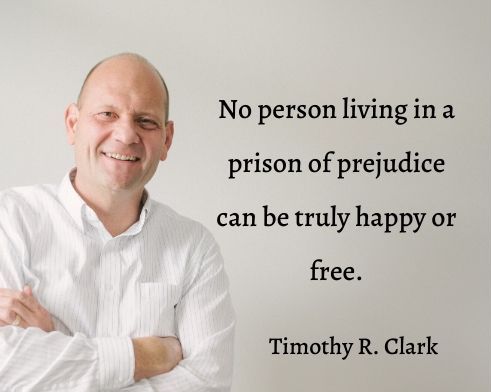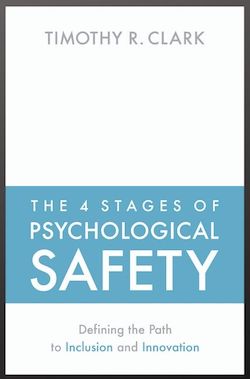
Guest Post by Timothy R. Clark
Many organizations have made great strides in creating diverse organizations, but most fall short when it comes to inclusion and fail to realize the full potential for increased creativity, better decisions and higher productivity.
They might achieve a representation of a range of human differences, but unfortunately most stop there, mistakenly assuming they will automatically have an inclusive culture.
Some organizations provide training to teach employees awareness, understanding, and appreciation for differences. That’s nice, but it’s simply a coat of paint. When we feel threatened, we get defensive, take counsel from our fears, and go back to our default settings of learned bias.
There’s not a person alive without some trace of negative bias against some human characteristic. Unconscious biases and prejudices are so deeply rooted in us, we often don’t even recognize we have them. It’s not easy to remove them, and they won’t magically go away. It requires commitment and hard work.
These three keys can help you move from diversity to real inclusion.
Serve Others
According to Nathaniel Branden, “Research shows that a well-developed sense of personal value and autonomy correlates significantly with kindness, generosity, social cooperation, and a spirit of mutual aid.” The lower someone’s self-esteem is, the harder it is for them to be inclusive. The most insecure people are often the most exclusive and that low sense of self spills into their interpersonal behavior.
The best and quickest way to increase your self-esteem is to develop your own capacity and confidence and perform acts of service for others, especially for those whom you struggle to include.
Practice Inclusion on the Job
Rather than providing away-from-the-job training sessions, a better way to help people move from diversity to real inclusion is to make it real – give them opportunities to practice inclusion in real life on the job. Make it experiential by creating diverse teams and assigning individuals to diverse mentoring or peer coaching relationships. And provide tools and support to help them succeed.
Behave Until You Believe
You learn inclusion when you practice inclusion because it produces its own confirming evidence. The more you practice it, the more you believe it, and the more real it becomes for you. The way to do that is simple: Affirm the individual worth of other human beings. Do I mean you should pretend? Wear the mask of an inclusive person? No, I mean earnest striving with real intent.
As you include people with action, you come to include them with emotion. The feeling of inclusion is the reward of the action of inclusion. In fact, if we fail to serve others, our relationships remain superficial, and even suspicious, until we close the distance. In that closeness—in living, working, eating, and breathing together—regard and affection finally arrive. If you don’t feel the way you want to feel toward an individual or group, the passage of time won’t change that, but your actions will. Act yourself into the emotion of inclusion.
No person living in a prison of prejudice can be truly happy or free.
I’ve lived and worked with people from all parts of the world, and I have observed that every nation, society, and family think they’re special. If we take special to mean singular or unique, I wholeheartedly agree. But if we take it to mean that we are better than our neighbors, I know where that comes from. We all want to count. We all want to matter. But it is foolish to try to convince ourselves that excluding others will make us count and matter more.
Note from Jesse: I am delighted to host this guest post by Timothy R. Clark which reflects some of the ideas in his newest book The 4 Stages of Psychological Safety: Defining the Path to Inclusion and Innovation, a practical, hands-on guide that shows how leaders can build psychological safety in their organizations, creating an environment where employees feel included, fully engaged, and encouraged to contribute their best efforts and ideas.
 Timothy R. Clark is founder & CEO of LeaderFactor, a leadership consulting and training organization specializing in emotional intelligence and psychological safety. Tim earned a Ph.D. in social science from Oxford University and is a five-time author, highly sought-after advisor, coach and facilitator to CEOs and senior leadership teams around the world. His new book: The 4 Stages of Psychological Safety: Defining the Path to Inclusion and Innovation (Berrett-Koehler) releases March 2020. Find out more about the book and psychological safety here: https://www.leaderfactor.com/the4stagesofpsychologicalsafety
Timothy R. Clark is founder & CEO of LeaderFactor, a leadership consulting and training organization specializing in emotional intelligence and psychological safety. Tim earned a Ph.D. in social science from Oxford University and is a five-time author, highly sought-after advisor, coach and facilitator to CEOs and senior leadership teams around the world. His new book: The 4 Stages of Psychological Safety: Defining the Path to Inclusion and Innovation (Berrett-Koehler) releases March 2020. Find out more about the book and psychological safety here: https://www.leaderfactor.com/the4stagesofpsychologicalsafety












